Key takeaways:
- Mother’s Day websites evoke emotions and foster connections, making it essential for themes to resonate with personal experiences and shared stories.
- Engaging with the target audience through feedback and understanding their needs helps in curating themes that appeal to diverse demographics.
- Personalization and interactive elements enhance visitor engagement by allowing users to share their own stories, creating a sense of community.
- Finalizing a theme should involve reflection on audience reactions and ensuring the chosen design authentically represents the essence of motherhood.
Understanding Mother’s Day Websites
Mother’s Day websites serve as heartfelt platforms where people connect and share their love and appreciation for mothers. I remember pouring over these sites myself, reflecting on my favorite memories, and feeling a mix of nostalgia and gratitude as I explored gift ideas and meaningful messages. Isn’t it interesting how a single day allows us to express emotions that often go unsaid throughout the year?
As I delved deeper into the world of Mother’s Day websites, I noticed a striking variety in themes and offerings. From DIY gift guides to unique event ideas, each site cultivates a special ambiance that speaks to different experiences of motherhood. I often found myself contemplating what makes a particular theme resonate so deeply—is it the imagery, the stories shared, or perhaps the universal struggles and triumphs of being a mother?
So, what truly makes a Mother’s Day website impactful? I believe it’s the way these platforms evoke emotions and foster connections. They can either celebrate the joyous moments or provide solace during times of loss. Reflecting on my journey, I realize that the best sites don’t just present products; they create a space for reflection and shared experiences, inviting us all to remember the powerful role mothers play in our lives.
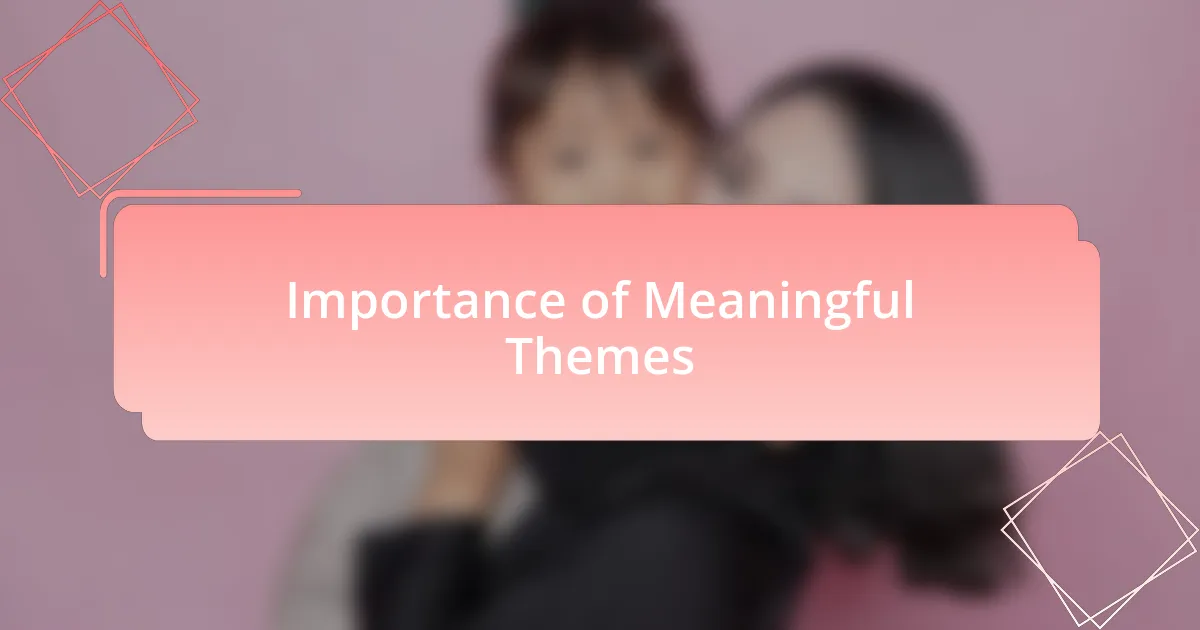
Importance of Meaningful Themes
The significance of meaningful themes in Mother’s Day websites cannot be overstated. When I think about the sites that truly touched my heart, I recall the ones that masterfully wove together visuals and narratives. For instance, one site used soft pastel colors and mother-child imagery that instantly transported me to moments shared with my own mom. It made me wonder: how can color and design evoke such strong emotional responses?
A well-chosen theme not only enhances the aesthetic appeal of a site but also aligns with the visitors’ emotional journeys. I remember visiting a site that featured personal stories from mothers themselves, sharing their triumphs and challenges. This approach not only made me feel connected but also inspired me to reflect on my journey as a parent. It’s clear that a meaningful theme can bridge the gap between personal experiences and broader societal connections.
Ultimately, the themes we select shape the atmosphere of the entire site, impacting how visitors engage with the content. One year, I stumbled upon a website that celebrated creativity with DIY projects, which reignited my passion for crafting. It created a sense of community—inviting everyone to contribute their stories. I can’t help but ask: how can we create this sense of belonging when choosing themes for our Mother’s Day websites? The answer lies in themes that resonate personally and inspire collective reflection.
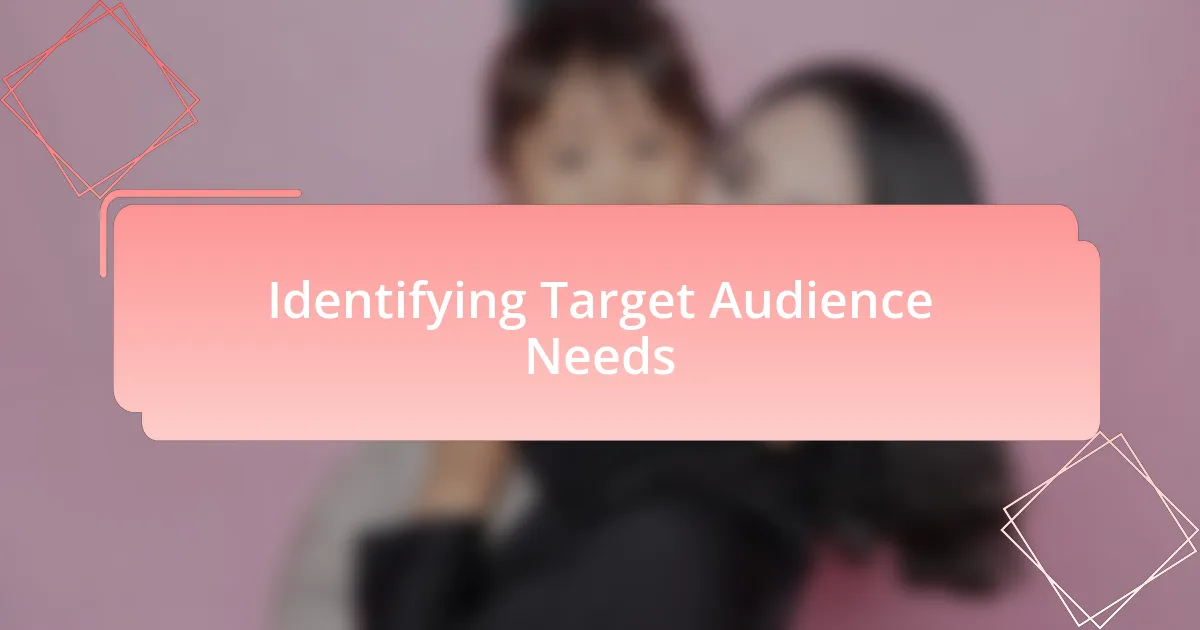
Identifying Target Audience Needs
When I think about identifying the needs of my target audience for a Mother’s Day website, I remember a time when I sought the perfect gift for my mom. I realized that no matter the charm of the website, what truly mattered was whether it understood what mothers cherish. Are they looking for heartfelt tributes, practical gift ideas, or perhaps DIY activities to share with their kids? This understanding is essential in shaping the website’s themes.
Additionally, I’ve found that engaging with potential visitors through surveys or social media is incredibly enlightening. There was a moment when I posted a question about favorite Mother’s Day memories on my social media. The responses were overwhelming! People opened up about their unique experiences, and it helped me recognize common threads—stories of love, sacrifice, and joy. This feedback profoundly influences how I select themes that resonate deeply with the audience.
It’s also interesting to note that demographics significantly shape the needs of the target audience. For instance, younger moms might appreciate fresh, trendy themes that cater to their contemporary lifestyles, embracing social media integration and interactive elements. In contrast, older generations might favor classic designs that reflect nostalgia and tradition. Reflecting on these differences can guide me in curating themes that not just attract any visitor but genuinely connect with their sentiments and experiences.
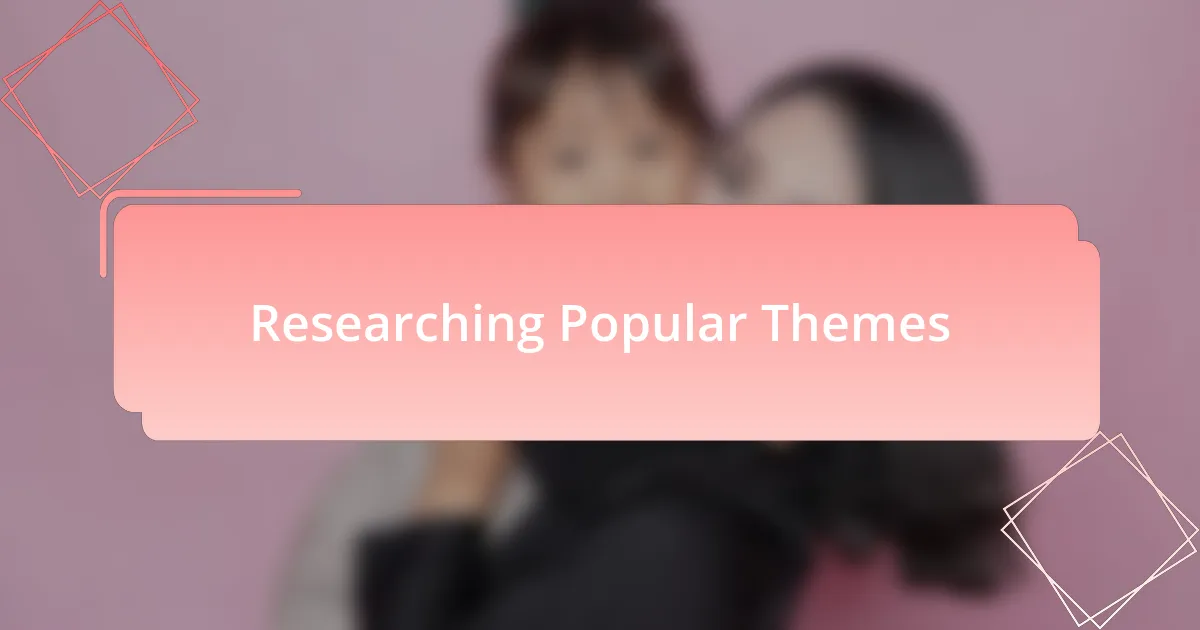
Researching Popular Themes
When delving into the realm of popular themes for a Mother’s Day website, I often turn to trend analysis. Websites like Pinterest and Instagram can provide a treasure trove of inspiration. For example, I remember scrolling through countless posts showcasing various Mother’s Day celebrations; the vibrant aesthetics and heartfelt messages truly stood out. Such platforms help me gauge what resonates with the audience, allowing me to incorporate those insights into the themes I select.
Additionally, exploring seasonal trends and color palettes plays a vital role in theme selection. One year, I noticed pastel colors were all the rage for Mother’s Day posts. I was amazed by how something as simple as a color scheme could evoke emotional responses and enhance the overall experience. This insight encouraged me to adopt similar hues in my website design, creating an inviting atmosphere that draws people in.
I also can’t underestimate the value of competitor analysis. By examining what successful Mother’s Day websites are doing, I’ve discovered emerging trends that could elevate my own. For instance, I once stumbled upon a site that cleverly combined user-generated content with thematic storytelling, which gave me the idea to create interactive sections where visitors could share their stories. How can I, too, develop themes that resonate and create bonds through shared experiences? It’s all about aligning my themes with what’s currently engaging others while still honoring the heartfelt essence of Mother’s Day.
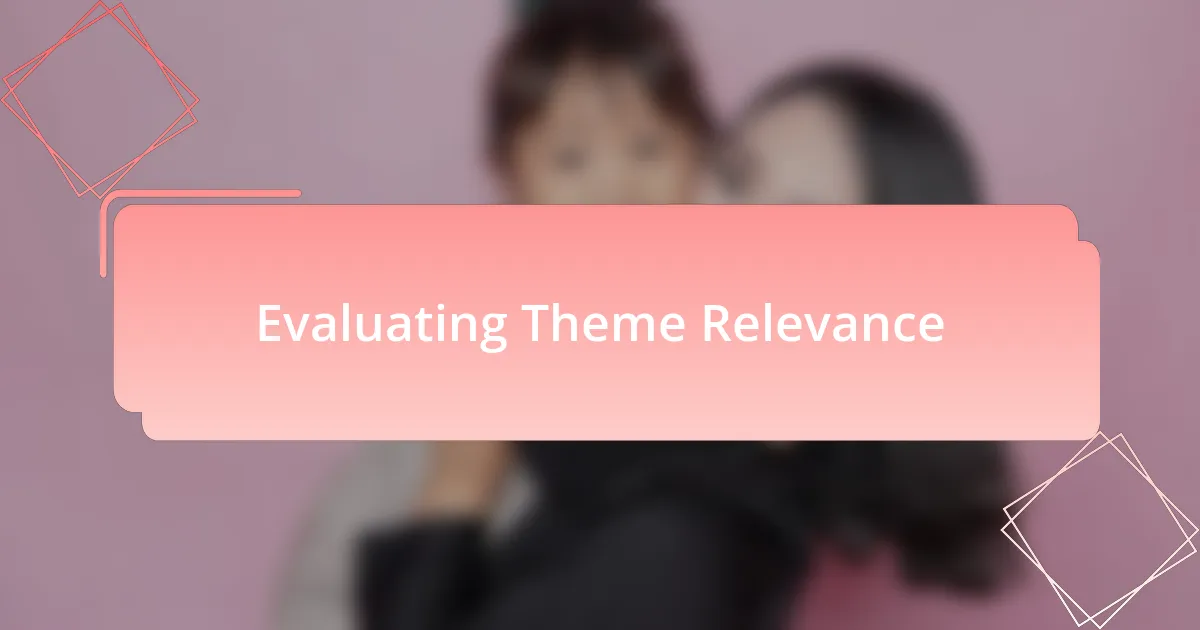
Evaluating Theme Relevance
Evaluating the relevance of a theme often requires me to dive deep into understanding the core values of Mother’s Day itself. I recall a time when I was drawn to a theme that highlighted the power of maternal bonds, featuring heartwarming stories and imagery. It struck me how crucial it is to ensure that a theme not only looks appealing but also resonates emotionally with visitors. Why is it essential to hit that emotional chord? Because a well-chosen theme can evoke feelings of nostalgia and appreciation that are central to celebrating mothers.
Another aspect that guides my evaluation process is audience feedback. After launching a theme centered on handmade gifts, I was pleasantly surprised by the overwhelming response it received. Many visitors shared their experiences of crafting special gifts for their mothers, bringing the theme to life. This feedback loop is vital—what better way to assess relevance than through the voices of those inspired by the website? Engaging users in this dialogue allows me to refine themes for future iterations, ensuring they remain meaningful and timely.
Lastly, I always consider the psychological impact of design elements within a theme. Once, while testing a theme featuring warm colors and soft fonts, I noticed that people lingered longer on my site. It made me wonder: how does the right visual harmony influence user experience? I believe that choosing themes that create a welcoming and soothing environment ties back to the essence of Mother’s Day, amplifying the emotional connection and keeping visitors engaged.
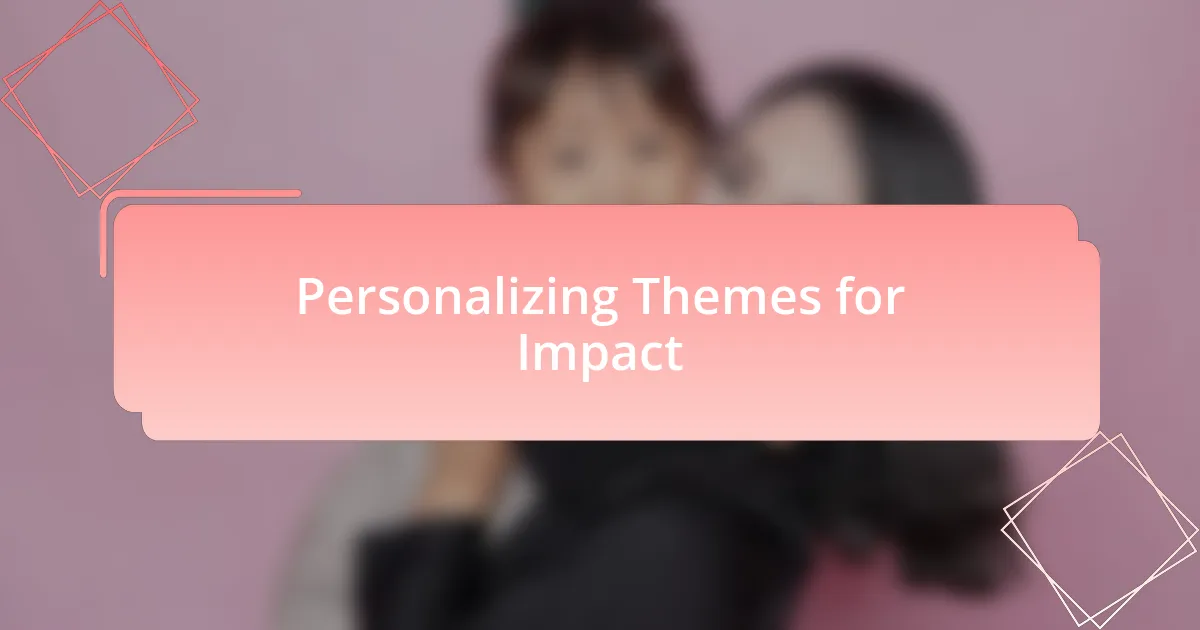
Personalizing Themes for Impact
Personalizing themes plays a significant role in creating a lasting impact on visitors. I remember when I tailored a theme around the unique stories of mothers from various cultures. It was fascinating to see how much more engaged users became as they related these narratives to their own experiences. Have you ever noticed how a personal touch can transform a simple design into a powerful storytelling medium? By weaving individual stories into the theme, I found that readers were not just passive observers; they were emotionally invested participants.
Considering personalization extends beyond just visuals; it also involves the language and tone used throughout the theme. For instance, I once experimented with incorporating direct quotes from mothers who had shared their journeys. The response was incredible—readers appreciated seeing their thoughts reflected back to them. It sparked a sense of community that I hadn’t anticipated. Isn’t it remarkable how the right words can foster connection? It reinforced my belief that personalized language is key to resonating with visitors on a deeper level.
Additionally, I prioritize interactive elements that allow visitors to contribute their own stories or insights. Once, I added a section where users could share their favorite Mother’s Day memories, and it ignited a flurry of participation. It wasn’t just about showcasing a theme; it became a platform for shared experiences. I truly think these interactions enrich the overall experience, making the theme feel more like a gathering place than a static representation. How might your own audience react if they felt their voices mattered within the theme? Personalization, in this sense, becomes a bridge that deepens connections and elevates the celebration of motherhood.

Finalizing Your Theme Selection
When finalizing your theme selection, it’s essential to reflect on what truly resonates with your audience. I once faced a dilemma between two compelling themes for a Mother’s Day website. After consulting with close friends and analyzing user feedback, I realized one theme encapsulated warmth and connection better than the other. It’s a reminder that your final choice should invite feedback and gauge potential reactions before committing.
Delving deeper, I suggest creating a shortlist of themes that align with your vision. Once, I shortlisted three different designs and showcased them to a small focus group. Their reactions helped me realize that the most visually stunning option didn’t communicate the heartfelt message I intended. Isn’t it interesting how our initial preferences can shift when viewed through someone else’s lens? Gathering diverse opinions can truly elevate your decision-making process.
Ultimately, your theme is a reflection of your intentions and values. One time, I chose a theme that emphasized empowerment, which resonated deeply with mothers sharing their stories. This choice allowed for a richer narrative to unfold on the site. I often ask myself, does this theme authentically represent the essence of motherhood? I believe it’s crucial for your selection to evoke the emotions and connections you wish to inspire in your audience.